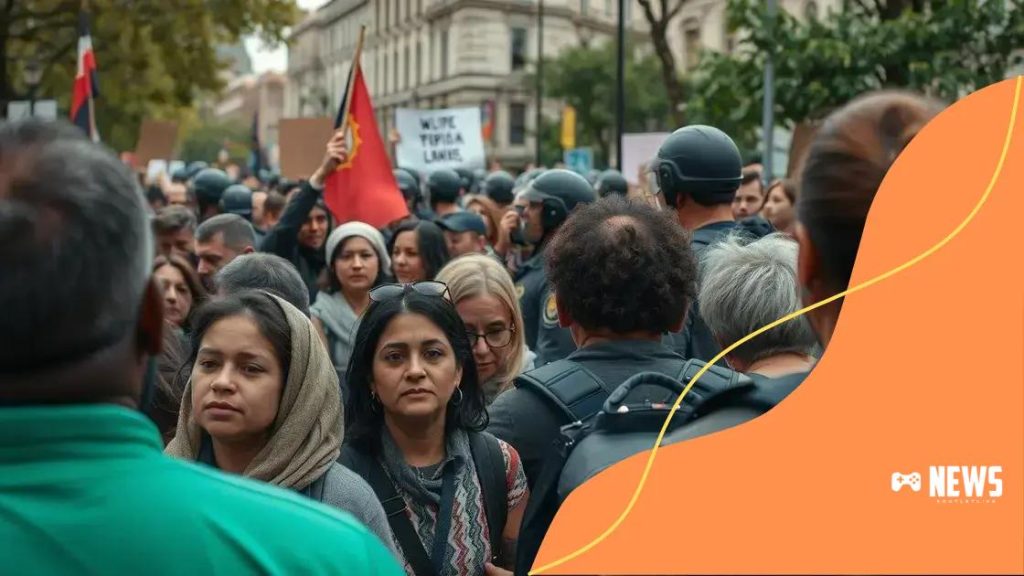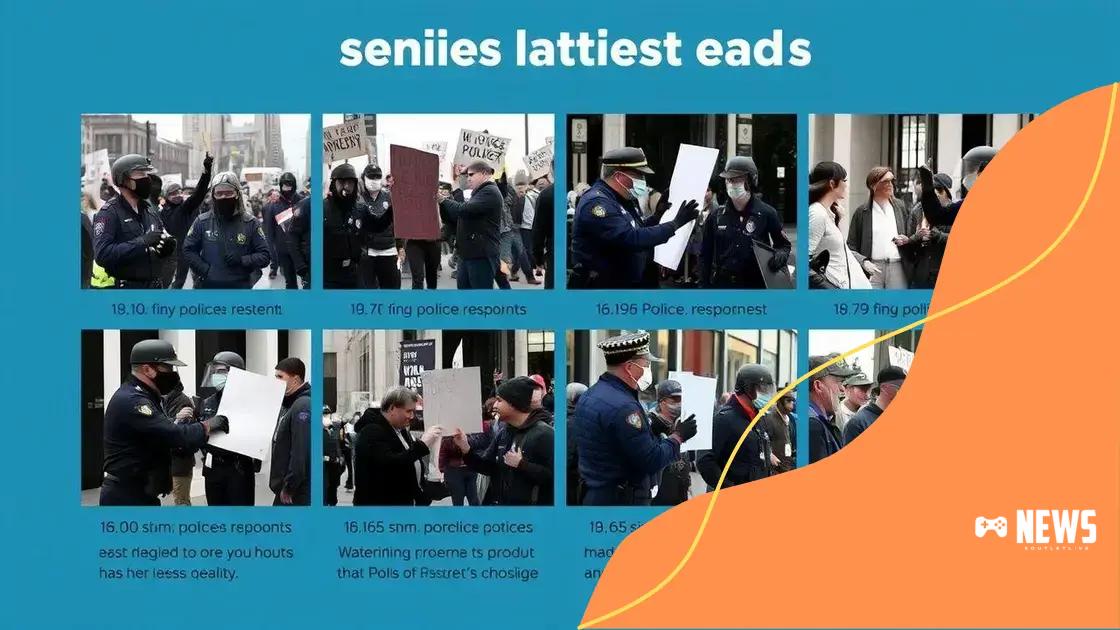Review of protest policing: understanding the challenges

Future trends in protest policing focus on community engagement, technology adoption, and enhanced officer training to ensure peaceful interactions during demonstrations.
Review of protest policing shows us a complex landscape of public safety, civil rights, and community dynamics. Have you ever wondered how law enforcement balances these challenges during protests?
Understanding the historical context of protest policing
Understanding the historical context of protest policing is essential to grasp the current dynamics between law enforcement and communities. Throughout history, protests have served as a platform for expressing grievances, challenging authority, and advocating for change. The evolution of policing methods in response to these protests has been shaped by societal attitudes, technological advancements, and historical events.
The roots of protest policing
Historically, protests in America have often led to a significant police presence. From labor movements in the late 19th century to civil rights marches in the 1960s, law enforcement has played a crucial role in managing, and sometimes suppressing, dissent. These interactions have laid the groundwork for current practices.
Key events that shaped policing tactics
Several key events have notably influenced police tactics during protests:
- The Haymarket Affair of 1886 highlighted the tensions between workers and police.
- The 1965 Watts riots showed the impact of racial tensions on policing.
- The Vietnam War protests in the 1960s illustrated the challenges of balancing public safety with civil liberties.
- The Ferguson protests in 2014 brought issues of systemic racism and police militarization to the forefront.
As we examine these events, it becomes evident that historical contexts significantly affect modern policing strategies. They reflect a continuous struggle to address the balance between security and the right to protest.
In recent years, the rise of technology, such as social media, has transformed the landscape of protests. This evolution has resulted in both challenges and opportunities for law enforcement. For instance, while social media can amplify messages and mobilize large groups, it also complicates the response strategies of police departments.
Furthermore, community relationships have significantly shifted. Many communities now demand transparency and accountability from police during protests. This evolution highlights the need for a focus on building trust between law enforcement and the public.Protest policing continues to evolve as a reflection of broader societal changes, suggesting that understanding its historical context is crucial for addressing future challenges and policies.
Key factors influencing protest policing decisions
Several key factors influence protest policing decisions. Understanding these factors can help us see why police respond in specific ways during demonstrations. These choices often involve balancing public safety, the rights of protesters, and community relations.
Legal considerations
One primary factor is the law. Various regulations govern how police can interact with protesters. These laws can differ dramatically based on location, impacting how protests are managed. Officers must stay within legal boundaries while ensuring safety.
Public perception and community relations
The relationship between law enforcement and the community significantly impacts protest responses. Police departments work to build trust with residents to foster cooperation during protests. When communities feel that their concerns are heard, the chances of peaceful demonstrations increase.
- Positive community relationships can lead to constructive dialogue.
- Trust helps officers manage protests effectively.
- Fear of public backlash may influence police strategies.
Additionally, the presence of technology plays a crucial role in shaping policing decisions. Social media platforms allow information to spread rapidly. This can lead to larger crowds gathering for protests, influencing how many officers are deployed. The media also affects perceptions, showcasing police actions to a wide audience.
Another important element is the internal training within police departments. Techniques used for managing crowds are often learned through ongoing training programs. Officers are taught how to de-escalate situations and communicate effectively with protesters. This training often helps police distinguish between peaceful and violent protests.
Resource allocation also affects how protests are managed. Many departments have limited staffing and budget constraints. These factors can influence the number of officers present at a protest and the strategies employed. Therefore, balancing available resources and the need for public safety is critical.
Case studies of notable protest responses

Examining case studies of notable protest responses helps us understand how different strategies can either escalate or de-escalate situations. These examples reveal essential lessons about protest policing and community engagement.
The Kent State University incident
In 1970, the tragic events at Kent State University demonstrated how a protest could turn violent. Students were protesting against the Vietnam War, and the National Guard was called in to manage the situation. During the confrontation, four students were shot, leading to nationwide outrage. This incident became a turning point, highlighting the need for police sensitivity and restraint during protests.
The BLM protests in 2020
More recently, the Black Lives Matter (BLM) protests in 2020 sparked significant debate about police responses. Following the murder of George Floyd, protests erupted across the country. Some police departments adopted a more community-focused approach, prioritizing dialogue and de-escalation techniques. This contrasted sharply with other areas that employed heavy-handed tactics, leading to increased tensions.
- Positive engagement strategies, like community policing, often yielded more peaceful outcomes.
- Departments that listened to community concerns experienced fewer violent clashes.
- Heavy police presence can lead to escalating conflicts instead of peaceful resolution.
These contrasting responses teach us about the effectiveness of tailored policing strategies. Effective communication and community involvement can often defuse potential violence before it escalates. Additionally, evaluating these responses shows how vital it is for law enforcement to adapt and learn from past experiences to manage future protests better.
Another relevant case is the G20 summit protests in Toronto in 2010. Police implemented a massive security presence aimed at controlling crowds. While some protests were peaceful, others resulted in clashes and arrests. The varying outcomes illustrated that a heavy police presence can provoke tensions rather than providing security. Recognizing the need for balance is crucial in managing protests effectively.
The impact of social media on policing during protests
The role of social media in policing during protests is significant. Platforms like Twitter, Facebook, and Instagram have transformed how information is shared and how law enforcement responds. Protests can gain momentum rapidly due to online communication, often leading to larger crowds than anticipated.
Real-time information sharing
With social media, updates on protests can spread in real-time. This rapid sharing allows individuals to organize and mobilize quickly. Police departments often monitor these platforms to gauge protest sizes and sentiment. However, the information can sometimes be misleading or sensationalized, complicating police responses.
Community engagement
Social media also serves as a tool for community engagement. Law enforcement agencies may use these platforms to communicate directly with the public, sharing safety information or seeking assistance in identifying potential risks. Positive or transparent interactions can help build trust between police and the community.
- Effective communication can reduce misunderstandings during protests.
- Police transparency can lead to a more understanding community.
- Social media campaigns can promote peaceful demonstrations.
However, there are challenges as well. Misinformation can lead to panic or escalated tensions. Instances where false narratives spread on social media can provoke violent reactions. Therefore, law enforcement must be prepared to address and correct misinformation quickly.
Additionally, the visual nature of social media means that police actions are often captured and shared widely. Videos and images can shape public perception, swaying opinions about specific incidents. Such content can lead to increased scrutiny of police tactics and decision-making, impacting how departments plan their responses.
Ultimately, the relationship between social media and policing during protests is complex. While it can facilitate communication and community engagement, it also presents new challenges. Law enforcement agencies need to adapt quickly to this evolving landscape, ensuring they respond appropriately to the unique dynamics of each protest.
Future trends in protest policing and community relations
Future trends in protest policing and community relations are likely to evolve as society changes. As movements for social justice grow, so does the need for police to adapt. Officers must develop new strategies to engage positively with the community during protests.
Increased focus on community policing
One emerging trend is the shift towards community policing. This approach encourages police to build relationships with community members. When officers engage regularly with citizens, it fosters trust. Enhanced community ties can lead to fewer tensions during protests.
Adoption of technology in policing
Technology will continue to play a vital role in future protest policing. Departments are increasingly using data analytics to understand protest dynamics better. By studying past protests, law enforcement can prepare more effectively. Drones and body cameras are being deployed for transparency and monitoring.
- Body cameras help provide accountability for police actions.
- Drones can offer aerial views of protest crowds to assess situations safely.
- Social media analysis helps identify potential flashpoints in real-time.
These advancements can lead to improved responses and better preparation. However, they also raise concerns about privacy and surveillance, which must be addressed to maintain public trust.
Engaging with community leaders and activists is another trend we might see more of in the future. Police are increasingly participating in dialogues with protesters before events. This proactive approach can lessen misunderstandings and help outline clear expectations.
Lastly, training for officers is likely to emphasize de-escalation techniques further. As the emphasis on human rights grows, it becomes essential for police to learn how to handle situations peacefully. Ongoing education on cultural competency will prepare officers for diverse communities.
FAQ – Frequently Asked Questions about Protest Policing
What role does social media play in protest policing?
Social media enables real-time information sharing, helping both protesters and police to stay informed about the situation and respond accordingly.
How can community engagement improve protest outcomes?
Building trust and communication between law enforcement and the community can lead to fewer misunderstandings and more peaceful protests.
What technology is being used in protest policing?
Technologies like body cameras and drones are used for transparency and monitoring, helping to ensure accountability during protests.
Why is training important for police during protests?
Training on de-escalation techniques and cultural competency helps officers manage situations peacefully and interact effectively with diverse communities.





